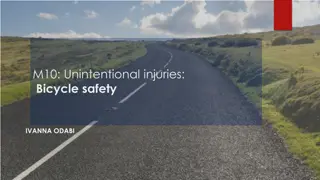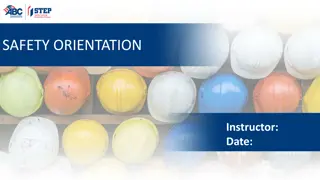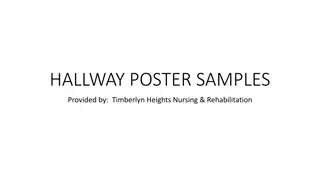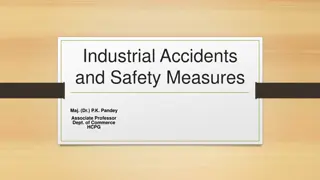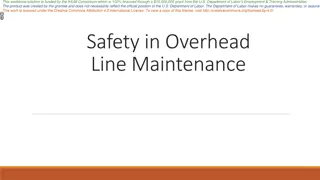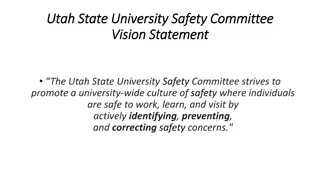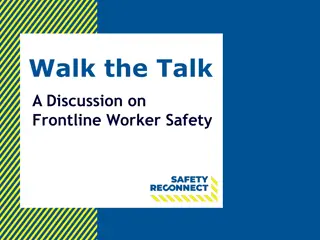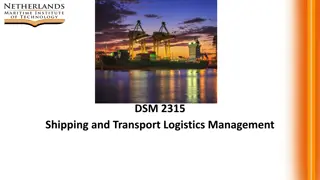Safety Measures for Working at Heights
Working at heights involves the risk of falls, which can lead to serious injuries. Legislation mandates proper risk management, training, and safety protocols to ensure the well-being of workers. Implementing systematic requirements and a hierarchy of controls can help prevent falls and create a safe working environment at elevated levels.
Download Presentation

Please find below an Image/Link to download the presentation.
The content on the website is provided AS IS for your information and personal use only. It may not be sold, licensed, or shared on other websites without obtaining consent from the author. Download presentation by click this link. If you encounter any issues during the download, it is possible that the publisher has removed the file from their server.
E N D
Presentation Transcript
WORKING AT HEIGHTS What is working at heights ? Working at heights is a situation where a person is exposed to a risk of a fall from one level to another that is reasonably likely to cause an injury. Risks can apply to all fall hazards from one level to another, REGARDLESS OF THE DISTANCE FROM THE GROUND.
LEGISLATION What the law says Legislation requires a person conducting a business or undertaking at a workplace to manage risks to health and safety associated with a fall by a person from one level to another that is reasonably likely to cause injury to the person or any other person.
LEGISLATION What the law says Workers have a duty to take reasonable care for their own health and safety and that they do not adversely affect the health and safety of other persons. Workers must comply with any reasonable instruction given by the person conducting the business or undertaking.
GENERAL HEIGHT SAFETY To manage the risk of a person falling from one level to another, a safe system of work must be implemented for any work at height.
GENERAL HEIGHT SAFETY Key systematic requirements include: The personnel assigned to work at height having the necessary training to carry out the work safely. Using the hierarchy of controls when considering methods for safe work at height. The strict compliance to all applicable Codes of Practice, Australian Standards obligations. The development of a rescue plan with all of the required equipment and available to enact the and legislative competent plan personnel
THE WORKING AT HEIGHT HIERARCHY OF CONTROLS Where the potential for a fall hazard exists, the highest reasonably practicable control to prevent a fall must be adopted. The primary duty is to eliminate the risk, however if this is not reasonably practicable, the risk must then be reduced to the minimum level.
LEVEL 1 CONTROLS (ELIMINATION) Always try to bring the job to ground level so that there is no risk of falling. Pre-assemble as much as possible at ground level. Where possible, have suppliers provide loads that are pre-slung to avoid access to rigging activities at height. If this is not possible, proceed to level 2 controls
LEVEL 2 CONTROLS Place a solid barrier or handrail, so that the risk of a fall from height is eliminated. Install roof safety mesh. Install perimeter screens or safety mesh. Use temporary work platforms, i.e. scaffolds, elevating work platforms, mast climbing work platforms or workboxes. If this is not possible, proceed to level 3 controls
LEVEL 3 CONTROLS Use a travel restraint device or a harness with a static lanyard that will prevent personnel from reaching a position where a fall is possible. Travel restriction systems must be selected, installed and used in accordance with AS 1891.4 (Industrial Fall Arrest Systems and Devices Series Parts1-4). Use industrial rope access systems. If this is not possible, proceed to a level 4 control
LEVEL 4 CONTROLS Use catch platforms to arrest a fall. Wear and use a harness and lanyard with an energy absorber that is connected to a suitable anchor point that will arrest a fall. When using a fall arrest system be aware of the pendulum effect
LEVEL 5 CONTROLS Undertake the work safely by following a procedure. Undertake the work safely from ladders or trestles. If this is not possible, STOP THE JOB and report to the person in charge. The specific controls selected must minimise the risk of falling to as low as reasonably practicable. Controls must be documented where necessary and incorporated within safe work method statements and risk assessments, as appropriate.
FALLING OBJECTS When work is being performed at heights, the following safety precautions should be taken to prevent objects from falling and injuring persons below: Objects must be raised and/or lowered in a controlled and safe manner. Delineate a drop zone and install signage. Restrict entry into the drop zone whenever work is being performed above. Ground personnel working near and/or entering a drop zone must wear head protection.
GENERAL REQUIREMENTS FOR WORKING ON LADDERS All ladders must comply with the AS/NZS 1892 Portable Ladders series, as applicable. The ladder must have a load rating of at least 120kg and must be manufactured for industrial use. The ladder must be set up on firm, stable and level ground. The ladder must only be used for that which it was designed.
GENERAL REQUIREMENTS FOR WORKING ON LADDERS The ladder must be checked before use to ensure that it is in good condition. All the locking devices on the ladder must be in place. The worker s body must remain within the space between the sides of the ladder. Three points of substantial contact must always be maintained while performing work on a ladder.
WORK AT HEIGHTS TRAINING Personnel assigned to work at height, where there is the potential of injury by falling from one level to another, or requiring the use of fall protection equipment, must have completed training to enable them to carry out the work safely.
WORK AT HEIGHTS RESCUE If using a fall arrest system as a measure to control risk, rescue procedures must implemented. The rescue procedures must be tested to ensure their effectiveness prior to the commencement of any work at height. All relevant workers who may be affected by the work at height rescue must receive suitable and adequate information, training and instruction in relation to the rescue procedures. be developed and
IN SUMMARY Well let s make this simple, shall we? You need to follow the hierarchy of controls we discussed earlier when you are working at height







